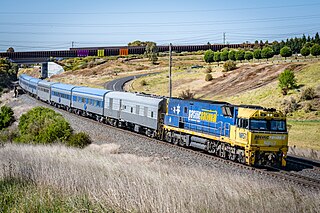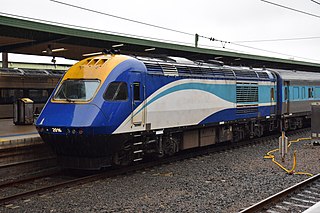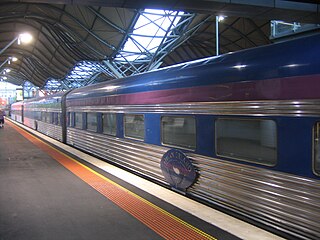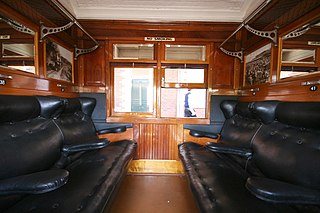Related Research Articles
A royal train is a set of railway carriages dedicated for the use of the king or other members of a royal family. Most monarchies with a railway system employ a set of royal carriages. If the monarch is an emperor the proper term is imperial train.

The Overland is an interstate passenger train service in Australia, travelling between the state capitals of Melbourne and Adelaide, a distance of 828 km (515 mi). It first ran in 1887 as the Adelaide Express, known by South Australians as the Melbourne Express. It was given its current name in 1936. Now operated by private company Journey Beyond, the train undertakes two return trips a week. Originally an overnight train that stopped at large intermediate stations, it now operates during the day, stopping less frequently.

The Blue Train travels an approximately 1,600-kilometre (990 mi) journey in South Africa between Pretoria and Cape Town. It is one of the most luxurious train journeys in the world. It offers butler service, two lounge cars, an observation car, and carriages with gold-tinted picture windows, in soundproofed, fully carpeted compartments, each with its own en-suite bathroom. The service is promoted as a "magnificent moving five-star hotel" by its operators, who note that kings and presidents have travelled on it.
The Westlander is an Australian passenger train operated by Queensland Rail on the Main and Western lines between Brisbane and the outback town of Charleville.

The Spirit of Progress was the premier express passenger train on the Victorian Railways in Australia, running from Melbourne to the New South Wales border at Albury, and later through to Sydney.

West Coast Railway was a passenger train company operating in Victoria, Australia that operated services between Melbourne and Warrnambool from September 1993 until August 2004. The travel time for the journey was around 3 hours. This is on average around 30 minutes quicker than the current journeys.

The New South Wales XPT is a class of diesel-powered passenger trains built by Comeng and ABB. Based on the British Rail-designed High Speed Train, each XPT set comprises two XP power cars in a push-pull configuration and, between them, between four and seven passenger carriages.

The Southern Aurora was an overnight express passenger train that operated between Australia's two largest cities, Sydney and Melbourne. First-class throughout, including the dining facilities, the Southern Aurora featured all-sleeper accommodation. The train first ran on 13 April 1962 after the opening of the North East standard gauge line from Melbourne to Albury, eliminating the break-of-gauge between the capital cities.

The S type carriages are a corridor-type passenger carriage used on the railways of Victoria, Australia. The first carriages were constructed by the Victorian Railways in 1937 for use on the Spirit of Progress, with additional carriages built for other trains until the mid-1950s.

The Victorian Railways' (VR) Royal Trains operated to transport members of the royal family on their numerous tours of Australia on the Victorian rail network. The same carriages were also used for a number of vice-regal trains for the governor-general of Australia and the governor of Victoria. The last Royal Train ran in 1988.

The Vinelander was an Australian passenger train operated by the Victorian Railways and, later, V/Line between Melbourne and Mildura from August 1972 until September 1993. Operating overnight along the Mildura line, it included motorail and sleeping car facilities.
The Sydney–Melbourne Express was an overnight intercapital passenger train service that operated between Australia's largest two cities, Sydney and Melbourne, between August 1986 and November 1993. Operated jointly by State Rail Authority and V/Line the name depended on the direction of travel, with the train nicknamed the 'Sex' or 'Mex'.
The Inlander is a passenger train that operates between Townsville and Mount Isa on the Great Northern railway line in Queensland, Australia. It was introduced by Queensland Rail on 12 February 1953 using new steel air-conditioned carriages built by Commonwealth Engineering, Rocklea.

Luxury trains are a premium passenger rail service. Some luxury trains promote tourism in destinations across a region, while others take passengers on a ride through a single country.
The New South Wales stainless steel carriage stock was a type of passenger carriage operated by the New South Wales Government Railways from 1961 until 1993.
This article is intended as a catalogue of sleeping carriages used by the Victorian Railways and successors.

The first carriages built specifically for The Overland train service operated by the Victorian and South Australian Railways (V & SAR) were introduced in 1949. By the end of 1951, eight new sleeping cars and six new sitting cars had entered service. Additions to the fleet continued until 1972; in all, 44 carriages were built. About eight were still in service in March 2020 on The Overland operated by Journey Beyond. Other carriages have been transferred to different services or sold.
V&SAR Intercolonial Express Carriages were carriages on a new train called the Intercolonial Express running on Victorian Railways and South Australian Railways in 1887. The track of two railways met on Wednesday 19 January 1887. The Victorian Railways' Western Line to Dimboola, and the South Australian Railways' Wolseley line, met at Serviceton. Since both sides shared the broad gauge of 5'3", an agreement was made between the two railways allowing a pool of carriages, classed O, to be specifically allocated to interstate trains linking the capitals of Melbourne and Adelaide. The operating and maintenance cost of the new train would be funded by both railways, approximately 60% paid for by the Victorian Railways and 40% by the South Australian Railways.

The E type carriages were wooden express passenger carriage used on the railways of Victoria, Australia. Originally introduced by Victorian Railways Chairman of Commissioners Thomas James Tait for the interstate service between Melbourne, Sydney and Adelaide, these Canadian-inspired carriages remained in regular service for 85 years over the entire Victorian network.
References
- 1 2 "Railway Cruising in Australia", Railway Gazette , 24 August 1934, pp.305-307
- ↑ "Train Cruises Resumed", Railway Gazette, 17 October 1947, p.433
- ↑ "Resources Train Tour", Railway Gazette, 1 May 1959, p.504